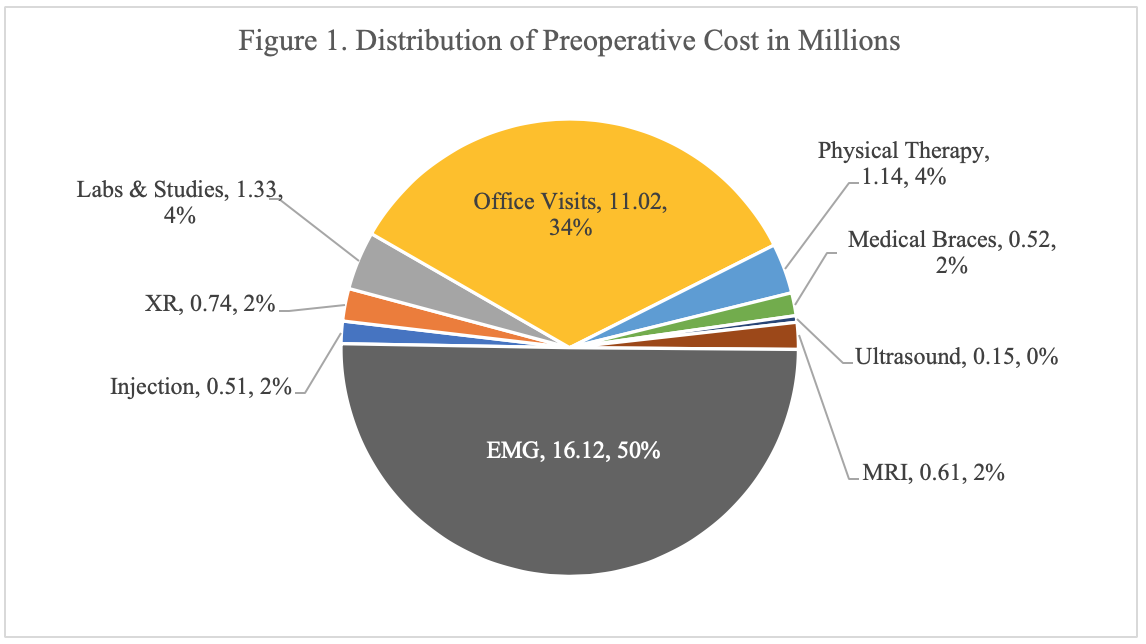Preoperative Diagnosis and Management of Cubital Tunnel Syndrome: How Does It Vary and What Does It Cost?
Corey C Spencer, BS1, Devin Collins, MD2, Paul T Greenfield, BS1, Alexander M Dawes, BS1, Roy J Toston, BS1, John T Hurt, BS1, Michael Gottschalk, MD3, Eric Wagner, MD1 and Charles Andrew Daly, MD1, (1)Emory University, Atlanta, GA, (2)Hughston Clinic, Columbus, GA, (3)Orthopedic Surgery, Emory School of Medicine, Atlanta, GA
Title: Preoperative Diagnosis and Management of Cubital Tunnel Syndrome: How Does It Vary and What Does It Cost?
Introduction: Clinical exam, EMG and NCS, Xray, ultrasound, and MRI are several measures commonly used by providers for workup and diagnosis of cubital tunnel syndrome. This study aims to analyze the utilization and costs of the various diagnostic modalities for the care Cubital Tunnel Syndrome. We hypothesize that effective diagnostic studies are underutilized in favor of more invasive, traditional, and expensive tests with less evidence for efficacy.
Methods: We queried the Truven Marketscan database to identify patients undergoing Cubital Tunnel Release from the 2010 to 2017. Patients were identified by common CPT codes and only included if they were enrolled for a minimum of 12 months prior to surgery. All associated CPT codes for each patient during the one year preoperative period were collected and filtered to only include those codes associated with ulnar neuropathy. The codes were then categorized as office visits, diagnostic imaging (XR, ultrasound, and MRI), EMG, injections, physical therapy, durable medical equipment, and preoperative labs. The frequency and associated cost for each category was determined.
Results: 51,581 patients (53.7% male to 46.3% female) were included in the study. A per-patient average cost (PPAC) of $623.28 was spent on preoperative workup alone. The highest contributing category was EMG (50.2%, PPAC: $312.55) and Office Visits (34.3%, $213.56). (Figure 1.) The most common diagnostic study used was EMG (56.3%), followed by x-ray (22.7%), and then Ultrasound (1.6%). (Table 1.) When analyzing by age group, the PPAC for patients 65 year old or older was significantly less than patients younger than 65 ($545.28 vs. $635.80, p<0.001), which was also associated with significantly lower utilization of steroid injections, PT, and medical bracing.
Discussion: Neurodiagnotic testing with EMGs is expensive and invasive to the patient, yet highly utilized, while ultrasound, a much cheaper, noninvasive alternative is only utilized less than 2% of the time. X ray has little to no value in the diagnosis of cubital tunnel syndrome alone yet is utilized in 23% of cases and represents 5% of total preoperative costs. Based on these findings, there is wide variability in the workup and diagnostic testing for cubital tunnel syndrome, which is likely secondary to there being no diagnostic reference standard. These findings can help identify areas where physicians can strive to reduce costs and provide more cost-effective treatment.
Back to 2021 ePosters


